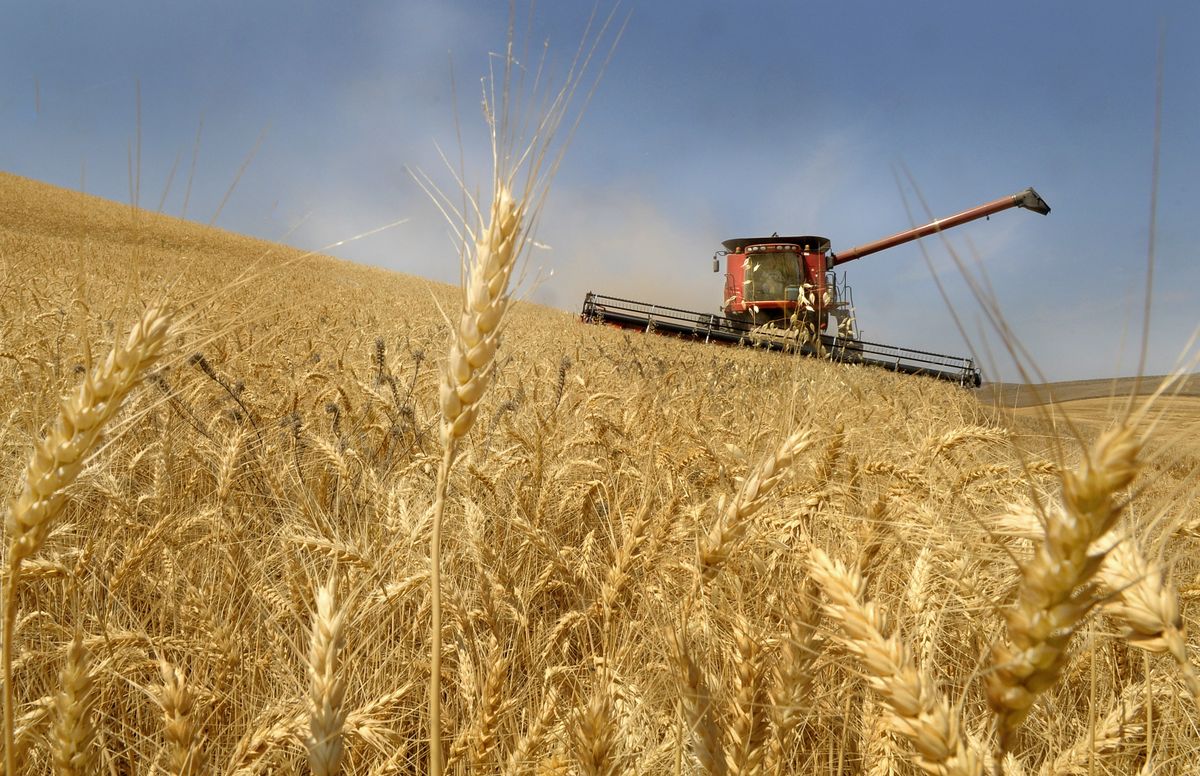Early July freeze tempers wheat farmers’ optimism
Region’s harvest under way after a record-price year

COLFAX – Winds that fanned wildfires in Spokane two weeks ago delivered a cold slap to farmers.
Temperatures the night of July 10 dipped into the mid-20s and nipped spring crops across the Palouse.
“Even froze gardens in Pullman,” said farmer Randy Suess, who said it’s normal for temperatures to swing 40 to 50 degrees during the course of a day.
Farming is wedded to weather, and this year is no different for the state’s upcoming billion-dollar harvest. Winter snows and a cool, wet spring aided wheat that was planted last fall. But the late spring and summer, topped by the surprise freeze, left farmers wondering about the wheat they seeded in April.
Standing next to spring wheat that’s taller than 3 feet, Suess anticipates the freeze will cut his yield by 15 percent.
Those numbers are a big disappointment for farmers who gambled this spring and planted more wheat than normal. The 600,000 acres of spring wheat, as reported by the U.S. Department of Agriculture, is expected to fetch about $8 a bushel. Even after farmers pay record prices for diesel fuel and chemicals, there should be enough left for a tidy profit.
Wheat prices have shattered records this year. Supplies of soft white wheat, the dominant variety grown in Eastern Washington and North Idaho, were so tight that a bushel fetched $15.68, said Glenn Squires, who tracks statistics and trends for the Washington Grain Alliance.
“The problem was that nobody had any,” Squires said.
That’s about to change. The Washington wheat harvest is under way. Combining starts in the south-central and southeast part of Eastern Washington then sweeps northeast in a broad arc before turning back south to the late-harvest, high-rainfall areas of the Palouse.
This week, Curtis Coombs, of Ganguet Farms near Walla Walla, was harvesting an excellent crop. Spotty weather spared the area, and farmers were happy with a yield topping 100 bushels per acre.
Wheat watchers say farmers will have an average crop at a time when farmers watch in amazement as market forces whipsaw their once staid industry.
“It was great this last year having high prices,” Suess said. “But on the other hand, a majority of people sold their wheat when it hit $5 to $6 because that was double what we’ve received for years. That’s why wheat went to $15 a bushel because there wasn’t any left to sell.”
Tom Mick, chief executive of the Washington Grain Alliance, said earlier this month that farmers may be more prone to hold their wheat rather than sell right away after harvest this year.
Fewer farmers entered into futures contracts after being stung last year when prices soared and they were locked in at far lower prices.
Until the price run-up of the past year, farmers relied on myriad federal subsidies and programs. Wheat routinely sold below what had been the widely held break-even price of $3.50 a bushel.
Suess said it’s unfair to pin high food prices solely on farmers.
“A lot of people blame farmers, but gee, we finally had one year to get out from under some debt load,” he said.
He added that at today’s prices, farmers collectively reap the equivalent of about 15 cents per loaf of bread.
That’s not much when a good deal on one whole wheat loaf is $2.50 to $3.
Even at such prices, Suess said, farmers receive little.
Consider this: the average combine will burn 150 gallons of diesel a day. Even with fuel-tax breaks for tractors and other field machinery, Suess figures diesel costs him in excess of $4.50 a gallon.
It makes every pass and every bushel a little more important, he said, frowning at the bare patches on hilltops that won’t yield much.
The late planting and mid-July freeze also touched rotation crops such as peas, lentils and chickpeas.
Despite the poor yield outlook for spring crops, Suess believes high prices will hold.
The nation’s corn and soybean crops are expected to disappoint. And because corn is a market driver, the shortages should help wheat trend higher.
Prices, though, depend mostly on global supplies.
Washington wheat is especially sensitive to global supply and demand because 85 to 90 percent of the annual crop is exported.
People in other countries prize soft white wheat for making flatbreads, cookies and pastries.
“We just have to wait and see,” Suess said.